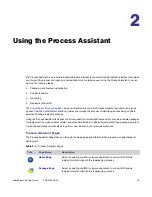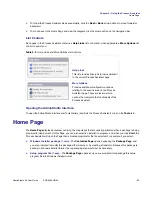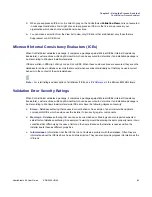
Chapter 2: Using the Process Assistant
Resolve Conflicts Page
84
ADS-0950-UG00
AdminStudio 9.5 User Guide
Importing Applications into the Application Catalog
You can import Windows Installer packages (
.msi
) with any associated transforms (
.mst
) or patches (.
msp
) and
merge modules (
.msm
) into the Application Catalog. Additionally, you can import OS snapshots (
.osc
), Marimba
Native Channel Packager (
.ncp
) files and other non-MSI based setup programs.
Once you import these files, they become available for conflict identification. Although you can identify conflicts
between an external package and packages already in ConflictSolver, it is strongly recommended you import the
package first and perform conflict identification after import. Conflict information is only persisted for the last
conflict identification performed between an external package and packages in ConflictSolver, and performance is
better when performing conflict identification between internal packages.
The Application Catalog also serves as a repository for all applications used in your organization. You can create
custom installations of a common Windows Installer package to distribute to different departments in your
organization, each installation including certain features that are appropriate for the department and excluding
certain features that are not appropriate.
Software Repository
If you are connected to an Application Catalog that has the Software Repository enabled, and you want to add the
package that you are importing to the Software Repository, select the
Add package to the Software Repository
option on the
Organize Package Page
of the ConflictSolver Process Assistant. See
About the Software
Repository
for more information.
Application Conflicts
Although a Windows Installer package or merge module may be built to guidelines put forth by Microsoft, it is
possible that the interaction between packages, or between a package and the base operating system, may cause
unwanted results in your production environment. You can use ConflictSolver to identify these conflicts before you
deploy packages, and resolve the problems before they affect your end users.
ConflictSolver allows you to check for a variety of conflict types, including file, component, and registry conflicts. In
many cases, ConflictSolver can resolve the issues automatically. ConflictSolver has rules to detect conflicts
involving: Components, Files, Registry Entries, Shortcuts, INI Files, ODBC Resources, NT Services, File
Extensions, and Product Properties.
Automatic and Manual Conflict Resolution
Automatic Conflict Resolution
To identify conflicts between multiple installation packages, ConflictSolver uses Application Conflict Evaluators
(ACEs). Some ACE failures can be resolved automatically by ConflictSolver. These automatic resolution
techniques are defined in Conflict Application Resolution Definition (CARD) rules. ACEs that can be automatically
resolved by CARDs are referred to as Best Practice ACEs: ACE02, ACE04, ACE05, ACE06, ACE07, ACE15, ACE18,
ACE19, ACE20. CARDs resolve errors found by the corresponding ACE of the same number.
Summary of Contents for ADMINSTUDIO 9.5
Page 1: ...AdminStudio 9 5 User Guide Version 9 5...
Page 50: ...Contents 50 ADS 0950 UG00 AdminStudio 9 5 User Guide...
Page 52: ...52 ADS 0950 UG00 AdminStudio 9 5 User Guide...
Page 156: ...156 ADS 0950 UG00 AdminStudio 9 5 User Guide...
Page 440: ...440 ADS 0950 UG00 AdminStudio 9 5 User Guide...
Page 1090: ...1090 ADS 0950 UG00 AdminStudio 9 5 User Guide...
Page 1426: ...1426 ADS 0950 UG00 AdminStudio 9 5 User Guide...
Page 1686: ...1686 ADS 0950 UG00 AdminStudio 9 5 User Guide...
Page 1794: ...Chapter 24 AdminStudio Public API Reference 1794 ADS 0950 UG00 AdminStudio 9 5 User Guide...
Page 1842: ...Index 1842 ADS 0950 UG00 AdminStudio 9 5 User Guide...
















































